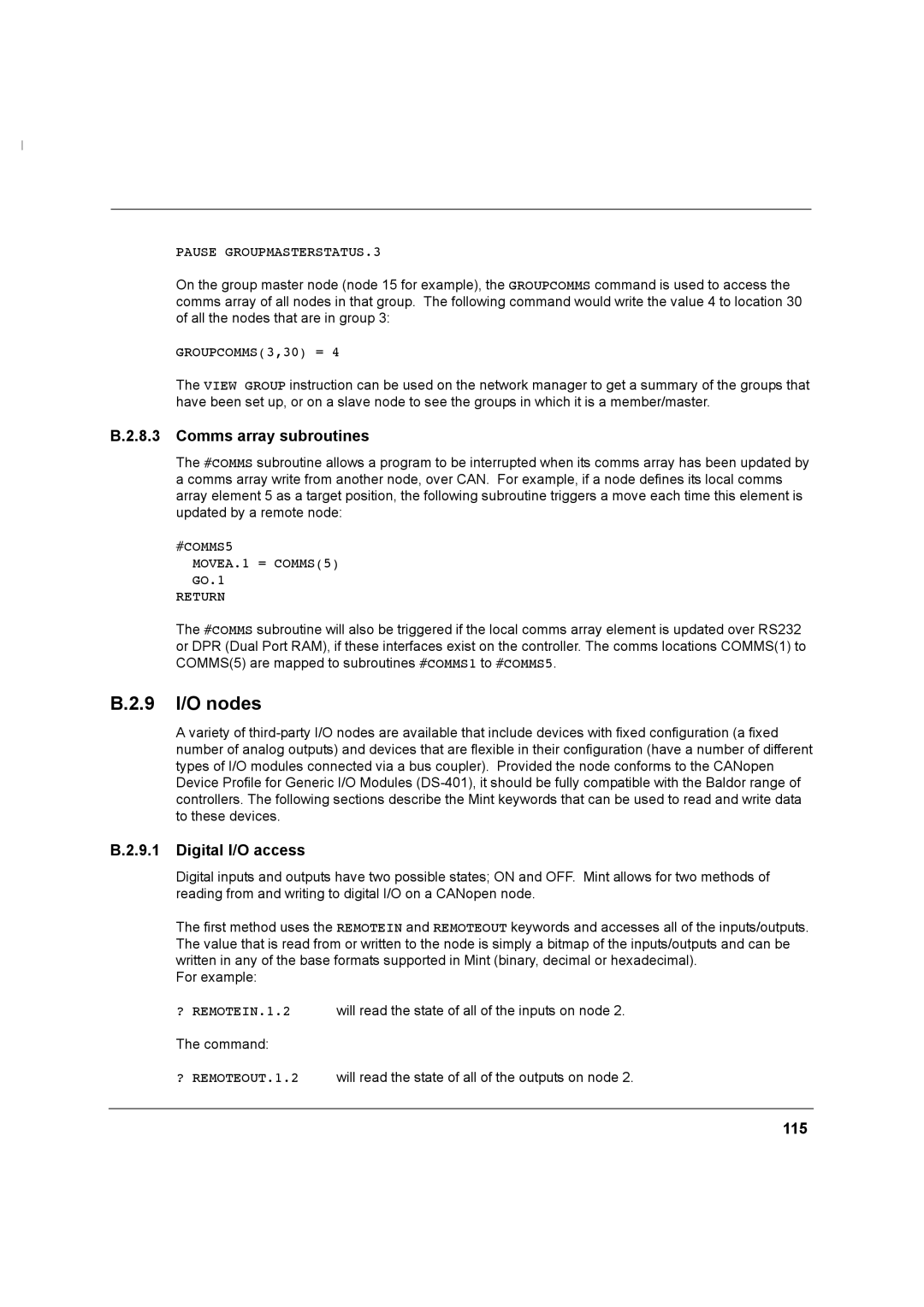MN1274 06/2001
Installation Manual
Page
Iii
Safety Notice
Circuit amperes listed here at rated voltage
Page
Contents
Viii
Input / Output
Mint WorkBench
Appendices
Tuning
129
Xii
Introduction
MintDrive features
Meaning Alternatives
Receiving and inspection
Identifying the catalog number
Date
Ready LED
MintDrive indicators
Monitor LED display
Can 1 and 2 LEDs
Units and abbreviations
Each step should be followed in sequence
You must read all the sections in Basic Installation
Outline
Hardware requirements
CBL
Tools and miscellaneous hardware
Power sources
Other information needed for installation
2 RS485 / RS422 systems
Mechanical installation and location requirements
Package dimensions
Dimensions and mounting
Power connections
Grounding
Single phase units
MintDrive
Power disconnect and protection devices
Input power conditioning
Ungrounded distribution systems
Circuit breaker and fuse, single phase, package size C
Delay
Wire sizes
Single phase connection to package size C
Single phase connection to package size a or B
8 24V control supply
Three phase connection to package size C
Input current
External drive
DC Bus power connections from package size C
Output voltage
MintDrive
Power supply filters
Nominal output voltage
Motor connections
Motor circuit contactors
Regeneration resistor mounting
Regeneration resistor Dynamic Brake resistor
Baldor regeneration resistor catalog numbers
Feedback connections
Pin Resolver function
Resolver option
Baldor Motor
Signal name Motor / cable Resolver cable wire Pin Color
Resolver cable pin configuration
Pin Encoder function
Encoder option
This completes the basic installation
Drive enable
Analog I/O
Input / Output
Description
Analog Input, Single Ended
Mint keyword
ADC.2
ADC.3
Analog Input, Differential
Analog Inputs, Differential
Pins Name
ADC.0 ADC.1
Page
AUXDAC.2 AUXDAC.3
Analog Outputs, Bipolar
AOUT0 and AOUT1 analog outputs
AUXDAC.0 AUXDAC.1
Digital I/O
Pin Name Mint keyword
Digital Inputs
External +24VDC supply Active high =+24VDC =0V Active low
X13
Thermal switch connection
X5 Digital inputs
External +24VDC supply Active high A=+24VDC B=0V Active low
Breakout board
Special functions on inputs DIN0 and DIN2
Input Function
OUT.7
Digital Outputs
OUT.5
OUT.6
OUT.3
OUT.4
OUT.2
OUT.0
MintDrive NextMoveBX encoder input
Other I/O
Simulated encoder output
Pin Name
Differential encoder connections
Master auxiliary encoder input
Auxiliary encoder circuit
Pin RS232 Name RS485 / RS422 name
Serial port
RS232 serial port connections
Using RS232 cable
Master Controller
Multidrop using RS485 / RS422 cable
Baldor HMI PLC Port
Connecting Baldor HMI Operator Panels
Can peripherals
Optional breakout board for connector
Installing the software
Connecting the MintDrive to the PC
Starting the MintDrive
Mint Configuration Tool Startup Wizard coarse tuning
Page
Page
An introduction to closed loop control
MCT Startup Wizard fine-tuning
Page
Fine-tuning the speed loop
Fine-tuning the position loop
Click Start Move
Jog test
Completing the Startup Wizard
Click Mint Configuration Tool in Wizard Mode
Digital input configuration
MCT Wizard hardware configuration
Digital output configuration
Axis0 error configuration
Axis0 parameter configuration
Miscellaneous configuration
Axis0 tuning configuration
Completing the configuration wizard
Page
Mint WorkBench
Completing configuration
Standard toolbar functions
Using WorkBench
Selecting the controller
Menus and buttons
Can window
Motion toolbar functions
Macro toolbar functions
Status bar
Quick Watch tab
Watch window
740 × L × A∕V
Speed Loop tab
Position Loop tab
Capture tab
Editor windows
Configuration window
Program window
To stop the motor turning, type
Useful commands for testing
Terminal window
To start the motor turning slowly, type
To turn a distance of 5 turns, type
Combining commands on one line
To change the speed, type
Prog
Firmware update
CON
NEW
Page
General specifications
Specifications
Power
Resolver feedback
Rectifier and regeneration
Encoder feedback
Control signals
Environmental
Page
Problem diagnosis
Troubleshooting
Communication
Problem Check
Corrupted. Use Release
Power up
Data Defaulting to
Tuning
Mint gains
Config = cfCURRENTAMPLIFIER
Code Problem Check
Print Drivefault
Ready LED is red
Parameter
Code Problem Check
7 can
Problem Check
Page
Purpose Name Abbreviation / keyword
Tuning a Introduction
Figure A.1 MintDrive Closed Loop System
Closed loop control
100
Position loop
101
Speed loop
Current loop
MintDrive operational modes
102
Tuning the position loop for a velocity servo drive
Tuning the position loop for a servo drive
Position Loop gain terms
KINTMODE=2
103
Position Loop Tuning using a trapezoidal move type
Position Loop Tuning using a step move
104
105
Tuning the position loop for a torque servo drive
Saving tuning information
CONFIG=6
106
107
MintDrive capabilities
Cable length Maximum bit rate Resistance Conductor area
108
Pin Name Description
Can 1 CANopen
Can 1 CANopen
109
110
What is CANopen?
Type Mint Constant Node Type
111
Configuring nodes
Network manager node
Scanning nodes
112
Connecting to nodes
? NODELIVE.1.2 ? NODETYPE.1.2
113
Monitoring can events
Event Number Mint Constant
114
Controller nodes
Singlecast communication
Broadcast communication
115
Digital I/O access
9 I/O nodes
Comms array subroutines
Extra Analog I/O Functionality
Analog I/O Access
116
117
HMI Operator Panels
REMOTEADCDELTA.1.2.3 =
118
Can 2 Baldor can
Can 2 Baldor can
119
120
Connecting the PC, MintDrive and can peripheral
Preparing the MintDrive
Preparing the can peripheral
Node IDs
Static configuration
Node type Type Mint Constant Default Node ID Baud rate
Remotesetup
122
Adding the node to the network
NODETYPE.7 =
123
Monitoring can Bus communications
Controlling the can peripheral
Normal operation
Pause NODELIVE.14
KeypadNode
124
BUS=2
125
IoNode 24/24
View NODELIVE.2
Example can network
126
NODESCAN.0
Keyword Abbreviation
Using abbreviations
Mint can related keywords
127
128
129
Declaration of Conformity
130
EMC wiring technique
EMC Conformity and CE marking
Use of CE compliant components
Grounding Earth
EMC installation suggestions
131
EMC filters
132
Wiring of shielded screened cables
Figure C.4 Handwheel Encoder cable grounding
Figure C.5 Encoder signal cable grounding
134
Cables
Cable Cable assembly Baldor catalog number Length
135
136
Resolver feedback cable
137
Filter dimensions FN351-36-33 and FN351-50-33
EMC mains filters
Catalog numbers
Dimension FN2070-6-06
Dimensions inches mm
138
115VAC drives 230VAC drives Baldor
Regeneration resistors
139
Baldor catalog number MintDrive
140
Breakout board
Page
MN1274 06/2001

